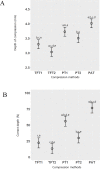Comparison of standard and alternative methods for chest compressions in a single rescuer infant CPR: A prospective simulation study
- PMID: 31851710
- PMCID: PMC6919614
- DOI: 10.1371/journal.pone.0226632
Comparison of standard and alternative methods for chest compressions in a single rescuer infant CPR: A prospective simulation study
Abstract
Objective: The aims of this study were to develop a novel three-finger chest compression technique (pinch technique; PT) and an assistive device chest compression technique (plate-assisted technique; PAT) and compare these techniques with conventional techniques.
Design: Prospective, crossover manikin study.
Setting: Pediatric emergency department at a tertiary care academic center.
Subjects: Fifty medical doctors and medical students.
Interventions: Using a manikin, fifty participants performed five different chest compression techniques-two 2-finger techniques (TFT1 and TFT2), two PTs (PT1 and PT2), and the PAT-for 2 minutes with 2 minutes of rest in a randomized sequence.
Measurements and main results: The compression depth (CD), compression rate, recoil, and finger position were recorded. At the study conclusion, each participant completed a 5-point Likert scale-based questionnaire on fatigue, satisfaction and difficulty of performing each technique. The mean CDs were 32.9 mm (TFT1), 30.3 mm (TFT2), 37.3 mm (PT1), 35.0 mm (PT2) and 40.1 mm (PAT) (p<0.001). TFT2 achieved the highest frequency of complete chest recoil, followed by PT1 and TFT1 (88.9%, 86.9%, and 81.4%, respectively, p = 0.003). The highest percentage of correct finger position was achieved by the PAT, followed by the PT1 and PT2 (93.4%, 83.1%, and 80.1%, respectively, p = 0.016). PAT use resulted in higher participant satisfaction, less fatigue, and less difficulty than the other four techniques.
Conclusion: Our new chest compression methods using three fingers and assistive plates showed better CD results than the conventional 2-finger technique.
Conflict of interest statement
The authors have declared that no competing interests exist.
Figures



Similar articles
-
Incomplete chest wall decompression: a clinical evaluation of CPR performance by trained laypersons and an assessment of alternative manual chest compression-decompression techniques.Resuscitation. 2006 Dec;71(3):341-51. doi: 10.1016/j.resuscitation.2006.03.021. Epub 2006 Oct 27. Resuscitation. 2006. PMID: 17070644 Clinical Trial.
-
Effectiveness of finger-marker for maintaining the correct compression point during paediatric resuscitation: A simulation study.Am J Emerg Med. 2017 Sep;35(9):1303-1308. doi: 10.1016/j.ajem.2017.04.003. Epub 2017 Apr 11. Am J Emerg Med. 2017. PMID: 28483276
-
Evaluation of new two-thumb chest compression technique for infant CPR performed by novice physicians. A randomized, crossover, manikin trial.Am J Emerg Med. 2017 Apr;35(4):604-609. doi: 10.1016/j.ajem.2016.12.045. Epub 2016 Dec 19. Am J Emerg Med. 2017. PMID: 28040386 Clinical Trial.
-
Comparison of two-thumb encircling and two-finger technique during infant cardiopulmonary resuscitation with single rescuer in simulation studies: A systematic review and meta-analysis.Medicine (Baltimore). 2019 Nov;98(45):e17853. doi: 10.1097/MD.0000000000017853. Medicine (Baltimore). 2019. PMID: 31702646 Free PMC article.
-
Analysis of Chest-Compression Depth and Full Recoil in Two Infant Chest-Compression Techniques Performed by a Single Rescuer: Systematic Review and Meta-Analysis.Int J Environ Res Public Health. 2020 Jun 5;17(11):4018. doi: 10.3390/ijerph17114018. Int J Environ Res Public Health. 2020. PMID: 32516929 Free PMC article.
Cited by
-
Four Different Finger Positions and Their Effects on Hemodynamic Changes during Chest Compression in Asphyxiated Neonatal Piglets.Children (Basel). 2023 Feb 1;10(2):283. doi: 10.3390/children10020283. Children (Basel). 2023. PMID: 36832412 Free PMC article.
-
2023 International Consensus on Cardiopulmonary Resuscitation and Emergency Cardiovascular Care Science With Treatment Recommendations: Summary From the Basic Life Support; Advanced Life Support; Pediatric Life Support; Neonatal Life Support; Education, Implementation, and Teams; and First Aid Task Forces.Circulation. 2023 Dec 12;148(24):e187-e280. doi: 10.1161/CIR.0000000000001179. Epub 2023 Nov 9. Circulation. 2023. PMID: 37942682 Free PMC article. Review.
-
Evaluating Novel Chest Compression Technique in Infant CPR: Enhancing Efficacy and Reducing Rescuer Fatigue in Single-Rescuer Scenarios.Children (Basel). 2025 Mar 10;12(3):346. doi: 10.3390/children12030346. Children (Basel). 2025. PMID: 40150628 Free PMC article.
References
-
- Atkins DL, Everson-Stewart S, Sears GK, Daya M, Osmond MH, Warden CR, et al. Epidemiology and outcomes from out-of-hospital cardiac arrest in children: The resuscitation outcomes consortium epistry-cardiac arrest. Circulation. 2009;119:1484–1491. 10.1161/CIRCULATIONAHA.108.802678 - DOI - PMC - PubMed
-
- Naim MY, Burke RV, McNally BF, Song L, Griffis HM, Berg RA, et al. Association of bystander cardiopulmonary resuscitation with overall and neurologically favorable survival after pediatric out-of-hospital cardiac arrest in the United States: A report from the cardiac arrest registry to enhance survival surveillance registry. JAMA Pediatr. 2017;171:133–141. 10.1001/jamapediatrics.2016.3643 - DOI - PubMed
-
- Atkins DL, Berger S, Duff JP, Gonzales JC, Hunt EA, Joyner BL, et al. Part 11: Pediatric basic life support and cardiopulmonary resuscitation quality: 2015 American heart association guidelines update for cardiopulmonary resuscitation and emergency cardiovascular care. Circulation. 2015;132:S519–S525. 10.1161/CIR.0000000000000265 - DOI - PubMed
Publication types
MeSH terms
LinkOut - more resources
Full Text Sources
Medical

